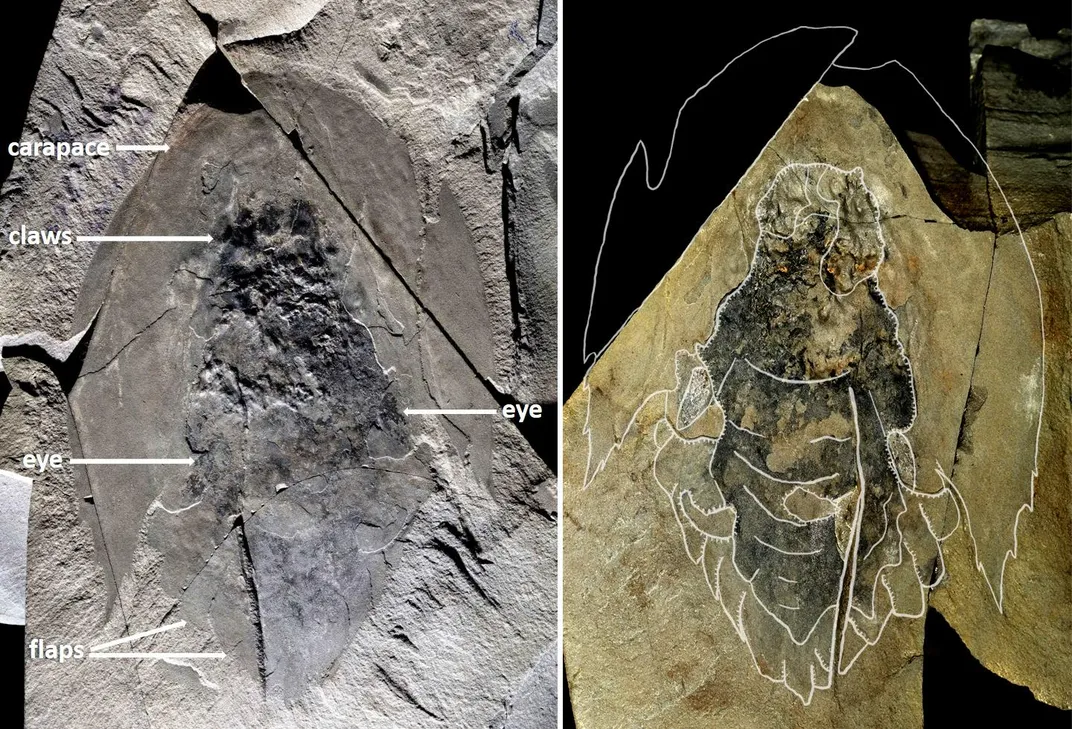Prehistoric Ocean Predator Resembles a Large and Vicious Horseshoe Crab
“Prey would have been sucked into the circular mouth and shredded by the multiple rows of large teeth”
:focal(980x761:981x762)/https://tf-cmsv2-smithsonianmag-media.s3.amazonaws.com/filer/7d/bb/7dbb96d6-0757-44ba-b1ee-afb00c38de84/207053.jpg)
What had a head that looked like a spaceship, a mouth shaped like a camera shutter, and claws that resembled sharp fork hoes? The answer isn’t the latest Guillermo del Toro creature creation. It’s Cambroraster falcatus, a 506 million-year-old invertebrate that was one of the top predators of the ancient seas.
The early arthropod is described today by Royal Ontario Museum paleontologists Joe Moysiuk and Jean-Bernard Caron in Proceedings of the Royal Society B: Biological Sciences. The Cambrian animal, whose name refers both to its rake-like appendages and a body shape that recalls the Millennium Falcon of Star Wars, isn’t quite like anything alive today. In technical terms, Cambroraster is a hurdiid radiodont, or an early arthropod belonging to a group with pineapple-shaped mouths and grasping appendages that included the first known large predators. The iconic Anomalocaris from the same vicinity is a relative.
The startling nature of Cambroraster took a few years to come together. “The first specimens were found in 2014,” Moysiuk says, as paleontologists explored the Cambrian rock of Canada’s Kootenay National Park. It was immediately clear that the animal, roughly resembling a modern horseshoe crab, was new to paleontology. “The carapace that covered the head of Cambroraster looked like nothing we had seen before.”

But there wasn’t just one fossil. Over years of fieldwork, researchers found hundreds of specimens, and paleo sleuthing back at the Royal Ontario Museum allowed Moysiuk and Caron to come up with a detailed picture of the entire animal. Given that most relatives of Cambroraster are known from bits and pieces, the chance to perceive and study an entire specimen offered a rare look at an enigmatic group of animals. “With Cambroraster we have everything preserved, and we have specimens showing how different body parts articulated with each other,” Moysiuk says.
Cambroraster resembles a mix of similar animals that have recently been uncovered. Among other radiodonts, the head shield of Cambroraster covers much more of the body than other species, University of Lausanne paleontologist Allison Daley says. The mouthparts of Cambroraster also resemble those of a related animal called Hurdia, she notes, but are spinier, and this mix of characteristics makes Cambroraster stand out.
In life, adult Cambroraster would have been about a foot long, which may seem relatively tiny by today’s standards, but during its time, Cambroraster was one of the largest animals around—and its anatomy suggests a rather voracious lifestyle.
“Cambroraster has a remarkable feeding apparatus consisting of a pair of frontal claws and a mouth ringed by toothed plates,” Moysiuk says. And on those claws are spikes that make a comb-like arrangement. Cambroraster likely used these appendages to sift through the seafloor sediment, devouring everything from worms to early fish relatives. But the invertebrate’s mouth is certainly its most frightening feature. After being captured in the claws, Moysiuk says, “prey would have been sucked into the circular mouth and shredded by the multiple rows of large teeth.”
Hundreds of Cambroraster have been found, sometimes with dozens preserved in the same spot. Finding so many fossils of this animal isn’t surprising, Daley says. The Kootenay fossil beds, like those of the nearby Burgess Shale, are world famous for their exceptional preservation.
“Many taxa, not just Cambroraster, are found very abundantly at these sites, which is part of what makes the Burgess Shale so special,” Daley says. Furthermore, many of the Cambroraster fossils are isolated body parts that were relatively sturdy—such as the claws, head shield or mouth parts, some of which may have been cast off as molts. This shedding may explain the aggregations of multiple Cambroraster in one place, Moysiuk notes, as modern arthropods often come together to exuviate their old exoskeletons. Nevertheless, finding so many Cambroraster in a relatively small area indicates that there was a thriving local ecosystem with a rich food supply for this predatory sediment-sifter.
Paleontologists are still putting together the details of this lost Cambrian world. The place where Cambroraster is found is only about 24 miles away from the famous Burgess Shale, yet, Moysiuk notes, the animals found at Kootenay are more closely related to species found in China than their Canadian neighbors. Exactly why this should be the case is a matter of ongoing research, Moysiuk notes, and experts are still working through the list of unusual new creatures found at Kootenay.
“Since the discovery of Marble Canyon in 2012, a number of new species have been described and many more remain to come,” Moysiuk says. And that’s just from the fossiliferous rocks that have been explored so far. Kootenay includes many spots that have yet to be sifted over and likely hold never-before-seen species.
“Endemism, when a species is confined to a defined and specific geological location, was high in the Cambrian,” Daley says. “So every new site that has been recently discovered has many new species found there that are unique in the world.” The more experts explore, the more familiar we’ll become with the strange nature of Cambrian life.
/https://tf-cmsv2-smithsonianmag-media.s3.amazonaws.com/accounts/headshot/RileyBlack.png)
/https://tf-cmsv2-smithsonianmag-media.s3.amazonaws.com/accounts/headshot/RileyBlack.png)